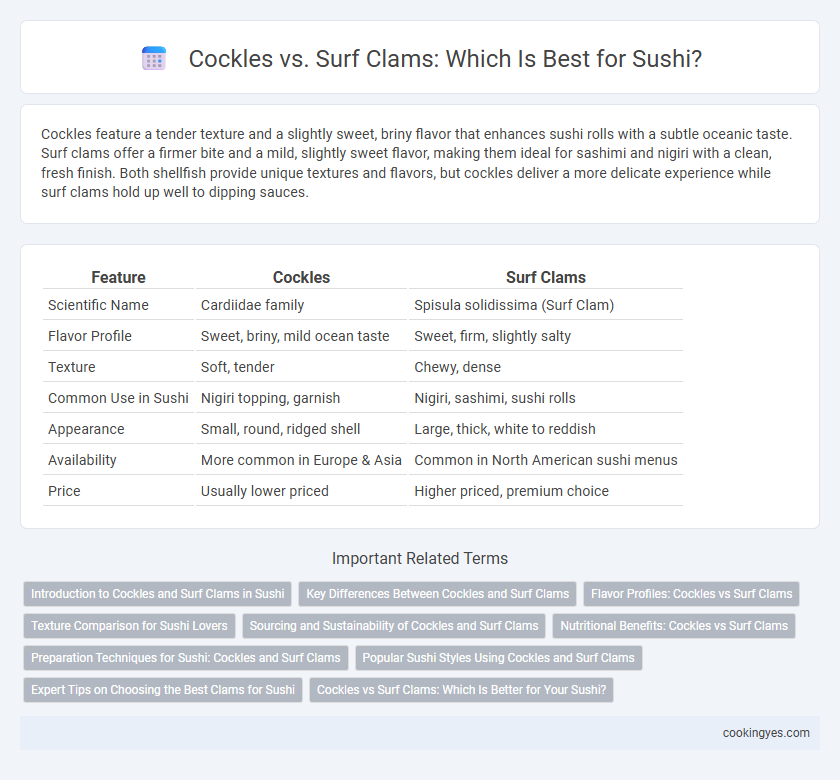Cockles feature a tender texture and a slightly sweet, briny flavor that enhances sushi rolls with a subtle oceanic taste. Surf clams offer a firmer bite and a mild, slightly sweet flavor, making them ideal for sashimi and nigiri with a clean, fresh finish. Both shellfish provide unique textures and flavors, but cockles deliver a more delicate experience while surf clams hold up well to dipping sauces.
Table of Comparison
| Feature | Cockles | Surf Clams |
|---|---|---|
| Scientific Name | Cardiidae family | Spisula solidissima (Surf Clam) |
| Flavor Profile | Sweet, briny, mild ocean taste | Sweet, firm, slightly salty |
| Texture | Soft, tender | Chewy, dense |
| Common Use in Sushi | Nigiri topping, garnish | Nigiri, sashimi, sushi rolls |
| Appearance | Small, round, ridged shell | Large, thick, white to reddish |
| Availability | More common in Europe & Asia | Common in North American sushi menus |
| Price | Usually lower priced | Higher priced, premium choice |
Introduction to Cockles and Surf Clams in Sushi
Cockles and surf clams are popular shellfish choices in sushi for their distinct textures and flavors. Cockles offer a sweet, briny taste with a tender yet slightly chewy texture, making them a unique addition to sushi and sashimi dishes. Surf clams provide a crisp bite and mild flavor, often served thinly sliced to highlight their natural sweetness and enhance the sushi experience.
Key Differences Between Cockles and Surf Clams
Cockles have a distinct rounded shell with pronounced ribbing and a sweeter, brinier flavor, while Surf clams possess smoother, elongated shells and a milder, slightly sweet taste. Cockles are smaller and more tender, making them ideal for raw preparations in sushi, whereas Surf clams are larger with a firmer texture, often used for sashimi and nigiri. Nutritionally, Surf clams offer higher protein content, whereas Cockles provide more iron and essential minerals, influencing their culinary application in sushi dishes.
Flavor Profiles: Cockles vs Surf Clams
Cockles offer a sweet, briny flavor with a tender yet slightly chewy texture, making them a popular choice for sushi that emphasizes delicate seafood taste. Surf clams present a milder, subtly sweet flavor with a firmer, crunchy texture, providing a contrasting mouthfeel ideal for diverse sushi presentations. Both shellfish complement sushi rice uniquely, with cockles enhancing umami richness while surf clams add refreshing, crisp notes.
Texture Comparison for Sushi Lovers
Cockles offer a firm yet tender texture with a slight chewiness that holds well in sushi, providing a satisfying bite without overpowering the delicate flavors. Surf clams deliver a crisp, slightly crunchy texture that adds a refreshing contrast to softer sushi ingredients, making them popular for nigiri and sashimi. Both shellfish enhance sushi with distinct textural profiles, catering to diverse preferences for bite and mouthfeel.
Sourcing and Sustainability of Cockles and Surf Clams
Cockles are typically harvested from shallow coastal waters using sustainable hand-raking methods, minimizing habitat disruption and ensuring population stability. Surf clams are often sourced from deeper offshore beds where dredging practices are regulated to reduce ecological impact and maintain seabed health. Sustainable sourcing of both cockles and surf clams involves strict quotas and monitoring programs to preserve marine biodiversity and support responsible seafood consumption.
Nutritional Benefits: Cockles vs Surf Clams
Cockles provide a rich source of iron and vitamin B12, essential for energy production and maintaining healthy red blood cells, making them a nutritious choice for sushi lovers. Surf clams offer higher protein content and abundant omega-3 fatty acids, promoting heart health and cognitive function. Both seafood options deliver valuable minerals like zinc and selenium, supporting immune function and antioxidant protection in the body.
Preparation Techniques for Sushi: Cockles and Surf Clams
Cockles require thorough rinsing and gentle boiling to remove sand and impurities before slicing for sushi, preserving their tender texture and briny flavor. Surf clams are typically blanched briefly to maintain firmness, then thinly sliced or shaved to enhance their sweet, oceanic taste in nigiri or sashimi. Both clams benefit from careful handling to retain freshness and subtle umami, making preparation a critical step in sushi quality.
Popular Sushi Styles Using Cockles and Surf Clams
Popular sushi styles featuring cockles include gunkan maki, where the briny, slightly sweet flavor of the cockles complements sushi rice wrapped in nori. Surf clams, known for their chewy texture and mild ocean taste, are often used in nigiri sushi, highlighting their natural flavor with minimal seasoning. Both shellfish varieties enhance traditional sushi dishes by adding unique textures and a fresh, savory seafood essence.
Expert Tips on Choosing the Best Clams for Sushi
When selecting clams for sushi, prioritize freshness and texture, with surf clams offering a firmer bite and a subtly sweet flavor ideal for sashimi and nigiri preparations. Cockles provide a saltier taste and tender texture, enhancing spicy rolls or ceviche-style dishes with their briny complexity. Expert chefs recommend sourcing from reputable suppliers who ensure sustainable harvesting and proper chilling to maintain optimal shellfish quality and safety.
Cockles vs Surf Clams: Which Is Better for Your Sushi?
Cockles and surf clams offer distinct textures and flavors that influence sushi quality, with cockles providing a tender, slightly sweet taste and surf clams delivering a firmer, mildly briny profile. Sushi chefs often prefer surf clams for nigiri due to their chewiness and visual appeal, while cockles are favored in sashimi and rolls for their delicate flavor and smooth bite. Selecting between cockles and surf clams depends on desired sushi texture and flavor balance, catering to specific culinary preferences and presentation styles.
Cockles vs Surf clams for sushi Infographic

 cookingyes.com
cookingyes.com